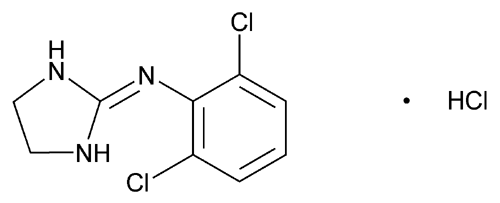Clonidine Hydrochloride
Benzenamine, 2,6-dichloro-N-2-imidazolidinylidene-, monohydrochloride.
2-[(2,6-Dichlorophenyl)imino]imidazolidine monohydrochloride
» Clonidine Hydrochloride contains not less than 98.5 percent and not more than 101.0 percent of C9H9Cl2N3·HCl, calculated on the dried basis.
Packaging and storage—
Preserve in tight containers. Store at 25 , excursions permitted between 15
, excursions permitted between 15 and 30
and 30 .
.
Identification—
B:
Ultraviolet Absorption  197U
197U —
—
Solution:
330 µg per mL.
Medium:
0.01 N hydrochloric acid.
Absorptivities at 272 nm, calculated on the dried basis, do not differ by more than 3.0%.
C:
It responds to the tests for Chloride  191
191 .
.
pH  791
791 :
between 3.5 and 5.5, in a solution (1 in 20).
:
between 3.5 and 5.5, in a solution (1 in 20).
Loss on drying  731
731 —
Dry it at 105
—
Dry it at 105 to constant weight: it loses not more than 0.5% of its weight.
to constant weight: it loses not more than 0.5% of its weight.
Residue on ignition  281
281 :
not more than 0.1%.
:
not more than 0.1%.
Chromatographic purity—
Dissolve 200 mg in methanol, and dilute with methanol to 2.0 mL to obtain the test solution. Dissolve a suitable quantity of USP Clonidine Hydrochloride RS in methanol to obtain a Standard solution having a known concentration of 100 mg per mL. Dilute a portion of this solution quantitatively and stepwise with methanol to obtain a diluted Standard solution having a concentration of 100 µg per mL. Apply separate 2-µL portions of the test solution, the Standard solution, and the diluted Standard solution to a suitable thin-layer chromatographic plate (see Chromatography  621
621 ) coated with a 0.25-mm layer of chromatographic silica gel mixture. Develop the chromatogram in a freshly prepared solvent system consisting of a mixture of toluene, dioxane, dehydrated alcohol, and ammonium hydroxide (10:8:2:1), until the solvent front has moved three-fourths of the length of the plate. Remove the plate from the chamber, allow the solvent to evaporate, and dry it at 100
) coated with a 0.25-mm layer of chromatographic silica gel mixture. Develop the chromatogram in a freshly prepared solvent system consisting of a mixture of toluene, dioxane, dehydrated alcohol, and ammonium hydroxide (10:8:2:1), until the solvent front has moved three-fourths of the length of the plate. Remove the plate from the chamber, allow the solvent to evaporate, and dry it at 100 for 1 hour. Dip the plate into a dipping chamber filled to three-fourths of its height with sodium hypochlorite solution, diluted to contain 0.5% available chlorine, dry in a fume hood with a current of air for 1 hour, and spray with starch-potassium iodide TS: the RF value of the principal spot from the test solution corresponds to that of the Standard solution. Any other spot obtained from the test solution does not exceed, in size or intensity, the principal spot obtained from the diluted Standard solution (0.1%), and the total of any spots does not exceed 0.2%.
for 1 hour. Dip the plate into a dipping chamber filled to three-fourths of its height with sodium hypochlorite solution, diluted to contain 0.5% available chlorine, dry in a fume hood with a current of air for 1 hour, and spray with starch-potassium iodide TS: the RF value of the principal spot from the test solution corresponds to that of the Standard solution. Any other spot obtained from the test solution does not exceed, in size or intensity, the principal spot obtained from the diluted Standard solution (0.1%), and the total of any spots does not exceed 0.2%.
Assay—
Dissolve about 200 mg of Clonidine Hydrochloride, accurately weighed, in about 80 mL of glacial acetic acid, add 15 mL of mercuric acetate TS, and titrate with 0.1 N perchloric acid VS, determining the endpoint potentiometrically, using a glass electrode and a sleeve-type calomel electrode containing 0.1 N lithium perchlorate in glacial acetic acid (see Titrimetry  541
541 ). Perform a blank determination, and make any necessary correction. Each mL of 0.1 N perchloric acid is equivalent to 26.66 mg of C9H9Cl2N3·HCl.
). Perform a blank determination, and make any necessary correction. Each mL of 0.1 N perchloric acid is equivalent to 26.66 mg of C9H9Cl2N3·HCl.
Auxiliary Information—
Please check for your question in the FAQs before contacting USP.
| Topic/Question | Contact | Expert Committee |
| Monograph | Sujatha Ramakrishna, Ph.D.
Scientist 1-301-816-8349 |
(MDCV05) Monograph Development-Cardiovascular |
| Reference Standards | Lili Wang, Technical Services Scientist 1-301-816-8129 RSTech@usp.org |
USP32–NF27 Page 1988
Pharmacopeial Forum: Volume No. 29(5) Page 1440
